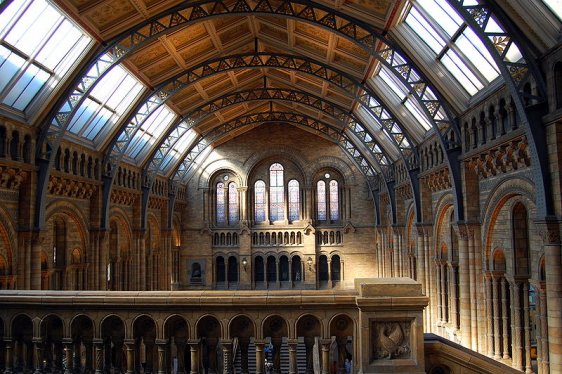The Natural History Museum, together with the Victoria and Albert Museum and the Science Museum are the three large museums on Exhibition Road, South Kensington, in the Royal Borough of Kensington and Chelsea. It faces Cromwell Road.
The Natural History Museum has some 70 million items broken into five main categories: Botany, Entomology, Mineralogy, Palaeontology and Zoology. It is a world-renowned centre of research, specialising in taxonomy, identification and conservation. The specimens include those collected by Charles Darwin, so they are of scientific as well as historical value.
 Central Hall, Natural History Museum
Central Hall, Natural History MuseumSource: https://commons.wikimedia.org/wiki/File:Central_Hall.JPG
Author: Minn Pongpaibul

The museum's collection began when Dr Hans Sloane allowed his collections to be bought over by the British Government at a price well below market value. Sloane's collection included dried plants, and animal as well as human skeletons. They were initially housed at the British Museum's premises at Montagnue House House in Bloomsbury in 1756.
In 1850, Professor Robert Owen, the Superintendent of the natural history departments of the British Museum, realised that space was running out. He needed a bigger, separate building for the growing collection. A piece of land at South Kensington was purchased for the purpose and in 1864, a competition was held to design the new museum building. The competition was won by Captain Francis Fawke, who died shortly afterward. The design was taken over by Alfred Waterhouse, who significantly altered it, and designed a façade in his own idiosyncratic Romanesque style. Work began in 1873, and the new museum building, called the Waterhouse Building, was occupied from 1881, though moving was not completed until 1883.
Terracotta tiles are used on both the interior and exterior of the Waterhouse Building. This is to resist the sooty climate of Victorian London. The tiles and bricks show sculptures of flora and fauna, with the existing and the extinct separated to the west and east wings of the museum. This is done because Professor Robert Owens want to rebut Darwin's attempt at linking present species with the past through his theory of natural selection.
Getting there
Nearest Tube station: South Kensington Tube StationBuses: Nos. 14, 49, 70, 74
Entrance Fee: Free, app. £5.00 for special exhibition
s Guided Tours: £3.00 adults, £1.50 children 5-16
Opening Hours
Mon-Sat: 10:00am - 5:50pmSun: 11:00am-5:50pm
What to see
The main entrance faces Cromwell Road. A grand flight of stairs leads from the main entrance into the Central Hall, a grand chamber with soaring ceiling not unlike a cathedral. The museum's exhibits are divided into Life Galleries and Earth Galleries.Within the Central Hall are exhibits of dinosaur skeletons, mammals, marine life, a display on evolution, among others, forming Gallery 10 of Life Galleries. Among the other highlights of the Life Galleries include more dinosaur skeletons (Room 21), a life-size model of a blue whale measuring close to 28 meters (93 feet) in Room 24 and an ant colony in Room 33.
Among the highlights of the Earth Galleries include exhibits on the Kobe earthquake, volcano eruptions, and an earthquake stimulator.
List of Museums in London

Copyright © 2003-2025 Timothy Tye. All Rights Reserved.

 Go Back
Go Back